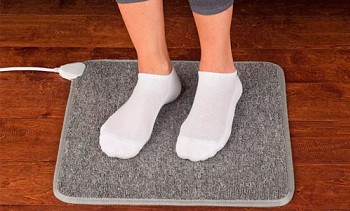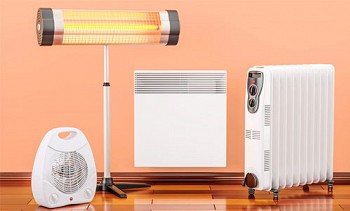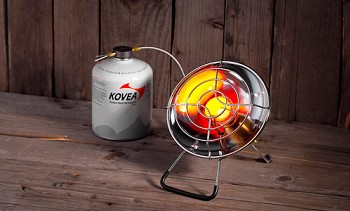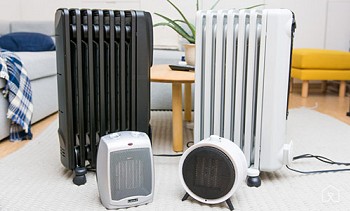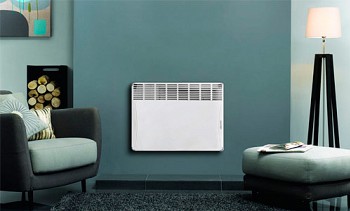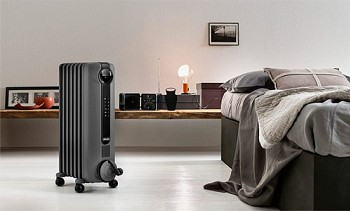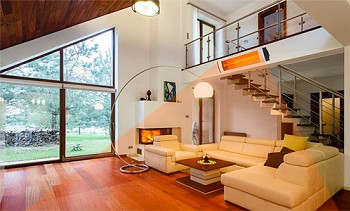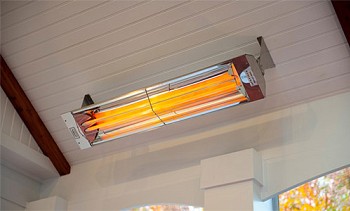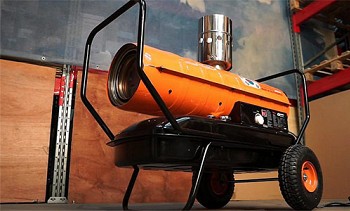Providing additional heat in a residential or commercial building is the most important factor in comfort during cold weather. To understand that a convector or infrared heater is better, we decided to analyze the main features of these types of devices. For analysis, such criteria as the principle of operation, the level of environmental friendliness and safety, price factor, dimensions, comfort of use, speed of heating the room, mobility and others were taken.
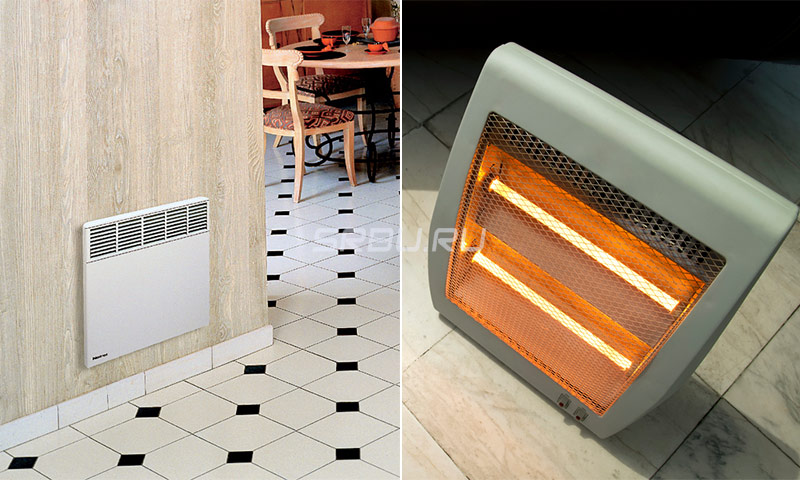
Content:
- What is the difference between an infrared heater and a convector
- Speed and heating features
- Which heater is more comfortable to use
- Which heater is safer to use
- Which heater is more environmentally friendly
- Dimensions of heaters
- The cost of the device
- Which heater is more durable
- What is more economical convector or infrared heater
- Comparison of infrared heaters and convectors
What is the difference between an infrared heater and a convector
Convectors
Convection-type heaters are represented by electric and gas models. In a residential environment, electric models are used. They are used in apartments, houses, in the country, in office premises - in all buildings where you can connect electrical power.
Convector operation principle. The convector makes heating of cold air and evenly distributes the heated in a heated room. Convectors do not radiate heat, like many heating appliances, but fill the room with it.
The device is placed at a height of not more than 15 cm from the floor. Next, the simple laws of physics apply: cold air is at the bottom, because it is heavier than warm air - it enters the heater through a special grill and passes through the radiator. Passing through the radiator, it heats up and enters the room. Warm air rises. As it cools, it drops, and the procedure repeats, providing constant heating of the air in the room.

Design features. The heater consists of two main parts: the body (convection chamber) and the built-in heating element. Ten does not come in contact with the metal case, so grounding is not required. Between the heating element and the housing there is a protective layer of special heat-resistant plastic. The process of air exchange is carried out naturally, without additional details inside the structure. Due to the lack of a fan, the silent operation of the convector is achieved.
Modern convectors are equipped with a thermostat, which ensures the maintenance of a stable indoor air temperature with a high level of accuracy. The user sets the required temperature, and the thermostat turns the device on and off as necessary. Control modules allow you to combine several convectors in a group and fully control the microclimate in the house.
Convectors are equipped with various additional options that help ensure maximum comfort in the room. The device can be equipped with a timer, indicators for connecting to electricity, a device for remote control, humidifier.

1. The front panel.
2. Lattice with guides for the release of warm air.
3. Power button.
4. Temperature adjustment.
5. The electronic module.
6. Closed heating element.
7. Temperature sensor.
Infrared heater
Infrared heater - a modern heating device used to heat rooms for various purposes.
The principle of operation of the infrared heater. The principle of operation of this device can be compared with sunlight.An infrared heater functions by heating objects in the room with infrared radiation - in turn, they give off heat to the air. This allows you to heat small areas or create local heating. To obtain the desired effect, you do not need to wait until all the air in the room or office heats up.

Design features. The main structural element is an emitter that emits infrared radiation and provides heating. Depending on the type of device, a halogen, carbon, ceramic or tubular heating element is used.
Reflector - a part of the design that provides directivity of heating and protection against overheating of the housing. It is made of modern materials with a high level of thermal resistance in parabolic or linear form.
A protective part in the form of a grill or partition to protect against direct contact with the hot surface of the emitter, a necessary element for the device used in a residential apartment or house.

1. Carry handle.
2. Protective grille.
3. The emitter.
4. Power button.
5. Reflector.
6. The leg.
Speed and heating features
Convectors work by filling the room with warm air in a natural convective way. These devices do not use fans or other additional elements that accelerate the heating process. Therefore, the heating rate relative to infrared devices is low.
The principle of operation of the infrared heater provides quick and directional heating, under the influence of infrared radiation. But first of all, objects, walls and people are heated, and the air in the room is already heated from them. It has been experimentally confirmed that heating is felt after 27 seconds. The directed action of the infrared heater allows you to achieve a comfortable temperature in the area of the room where people are located. In this case, the accumulation of warm air near the ceiling will be minimized.

The difference in heat distribution when using a convector and ceiling infrared heater.
The fastest person will feel the heat from an infrared heater, however, if we talk about uniform heating of air throughout the room, then a convector will cope faster. The directed action of the infrared heater allows the use of these devices in those places where drafts are present - on terraces, in gazebos and production rooms. The convector is able to provide uniform heating of air in a closed room.
Which heater is more comfortable to use
Electric convectors are presented in two versions of models, based on the installation features. Wall models are attached to the wall at a height of 10 - 15 cm from the floor. Installation does not take much time. After fixing the device on the wall, it does not interfere with movement in the room and is not striking.

Floor models - compact, equipped with castors or legs-stands. Due to its light weight and parameters, the device is easy to transfer from one room to another. The presence of additional functions increases ease of use.

Infrared heaters are divided into mobile and stationary. Mobile models of infrared heaters can easily be moved within the room or moved to another room. However, the body of the infrared heater is often very hot, so you must be careful when changing the orientation of the device or moving it to another room. Although the protective grid protects against direct contact with the emitter, it has a fairly high temperature.

As for stationary infrared heaters, they are practically no different, in this regard, from convection heaters. They are installed on the walls or ceiling and do not cause any inconvenience to the inhabitants of the room.

Convectors will be more comfortable to use.They do not require such control as infrared devices. The convector can be easily left unattended, while a powerful infrared heater can radiate a large amount of heat, which can lead to negative consequences for both a person and closely placed surrounding objects. Both devices are silent. However, users note that some models of infrared heaters emit a crack when heating and cooling, caused by thermal expansion of parts.
Which heater is safer to use
Electric convectors comply with all fire safety requirements and are equipped with overheat protection. Thanks to the special protection of the heating element, the heating part does not touch the metal casing, so there is no need for grounding. The convector surface does not overheat. Wall options are securely mounted on the wall, and floor models are stable.
The heating element of the infrared heater has a high temperature, so its surface is closed by a partition or mesh - this protects against burns when accidentally touched. Models are equipped with overheat and fall protection functions. Radiation is safe for humans, but it is not worth it to abuse and be under its influence for a long time.
In terms of safety, the convector will be much more reliable. It does not have very hot elements and does not produce radiation. Infrared heaters, when used correctly, comply with fire safety standards, but they are more fire hazardous devices. In addition, it should be mentioned that being under too much infrared radiation for a long time is not very good for health. This can be compared with prolonged exposure to the scorching sun. Of course there will be no fatal outcome, but a headache can be guaranteed.
Which heater is more environmentally friendly
The specifics of the convector's work indicate that when the air moves in the room, dust will rise. Convection during operation of the infrared device is present, but it is weakly expressed.
Often you can hear the opinion that this or that type of domestic heater burns oxygen. In fact, not a single heater using an electric network burns oxygen, since there is no open burning. That is why this feature cannot be used as a merit of some and a disadvantage of other types of heaters.
Both devices, in the course of their work, do not emit harmful substances, however, dust raised during the operation of the convector can be very harmful for allergy sufferers. Intensively working convectors are able to reduce the humidity level in the room more than infrared models. The infrared heater does not have a strong convective movement of air masses. But here it is necessary to ensure that dust and other small objects that can burn out creating an unpleasant odor do not get on the emitter.
Dimensions of heaters
Convectors are thin, but rather large in height and width of the device. Due to the small thickness, wall-mounted models, after installation, are almost not conspicuous.

Dimensions of infrared devices depend on the type and technical features of the device. The most compact models of portable type for spot heating.

Ceiling models have a considerable length (about 1 - 2 m.). But they are located in those places where they do not in any way affect the area of the room.

Ceiling IR heaters.
If you compare mobile devices that can be transferred from one room to another, then among them you can find infrared heaters of a very small size, approximately 25-30 cm in width and height. The principle of operation of the convector does not allow to make these devices as small. As a rule, convectors have a width of at least 44 cm and a height of at least 41 cm.
The cost of the device
Prices are presented in a wide range of options.
Pricing Factors:
- Power;
- Features and additional properties;
- Brand
Average prices of household infrared heaters: 2400 - 4000 rubles. Average prices of electric convectors: 1800 - 3500 rubles. Models with a mechanical thermostat are 20 to 30% cheaper than designs with an electronic or programmable device.
Which heater is more durable
The principle of operation of convectors allows for a long period of successful operation. Most manufacturers guarantee 5 years of operation. Practical user experience indicates an average life of 10-15 years.
Depending on the type of heater, the correctness and characteristics of the operating conditions, the service life of the infrared heater can be from 15 to 25 years. Ceramic models have the longest life.
What is more economical convector or infrared heater
The level of energy consumed depends on the technical features of the device. According to studies, the use of infrared models is more economical. Energy costs depend on the temperature in the street, the desired room temperature, the level and quality of the insulation of the room, the area of the windows and the quality of the double-glazed windows.
If we compare devices of the same power, they consume approximately the same amount of energy. Saving the use of an infrared heater is achieved by the fact that in order to create a comfortable temperature in the room it needs to work less time than a similar convector. Therefore, the infrared heater can be turned on for 20 to 30 minutes per hour, while the convector should work without interruption.
Comparison of infrared heaters and convectors
 |  | |||||||
|---|---|---|---|---|---|---|---|---|
| Infrared heater | Convector heater | |||||||
| Productivity, Efficiency | 90 - 95% | 95% | ||||||
| Heating time | quick warm up | slow warm up | ||||||
| Features of heating | heats objects, walls and people | warms the air | ||||||
| Comfort of use | middle | tall | ||||||
| Security | have protection against overheating, but some devices cannot be left unattended | have protection against overheating, can be left unattended | ||||||
| Environmental friendliness | good, but there may be a burnout of dust entering the emitter | during convection dust rises | ||||||
| Noise level | some models may make small sounds due to thermal expansion | completely silent devices | ||||||
| Versatility | more universal, can be used both for indoor and outdoor heating | less universal, their use is limited | ||||||
| Mobility | floor models are small | have a larger size | ||||||
| Economical use | medium or high | medium or low | ||||||
| Lifetime | 15 -25 years old | 10 - 15 years | ||||||
| Use as a primary heating system | It is possible to combine many devices into a single network of ceiling heaters | it is possible to integrate many devices into a single network of wall convectors | ||||||
It is difficult to say unequivocally which heater is better than an infrared or convector, it all depends on your needs and operating conditions. We can give some recommendations on this subject.
The feasibility of using an infrared heater:

It is required to provide only a point, uneven heating in a certain area of the room.
It requires heating in a room with drafts or on terraces, a gazebo, awnings.
You need a mobile device that you can carry with you, for example, to work.
The feasibility of using a convector heater:

It is necessary to ensure constant uniform heating of the room, which has no drafts.
It is necessary to heat the room where small children can be.

